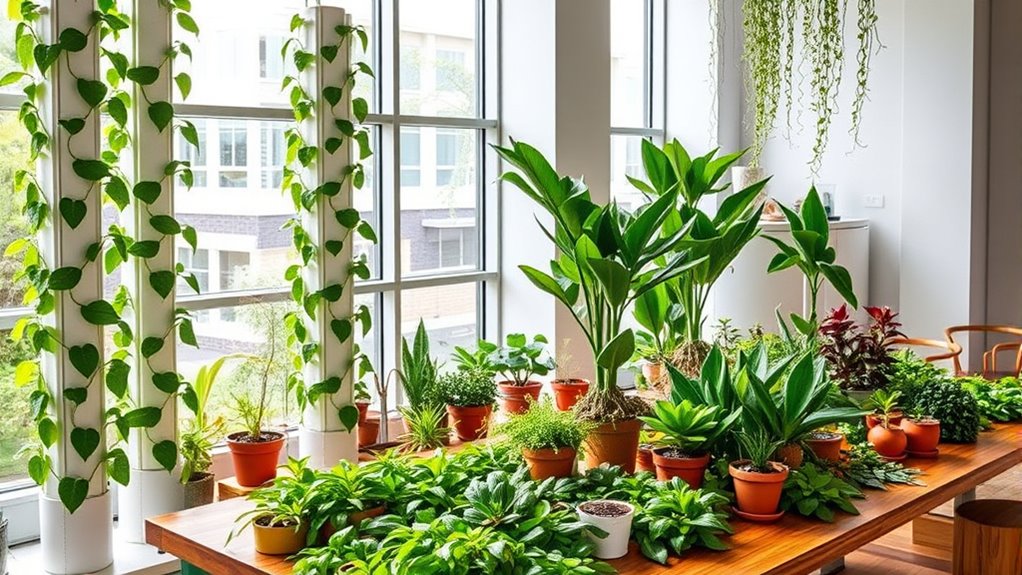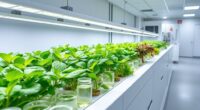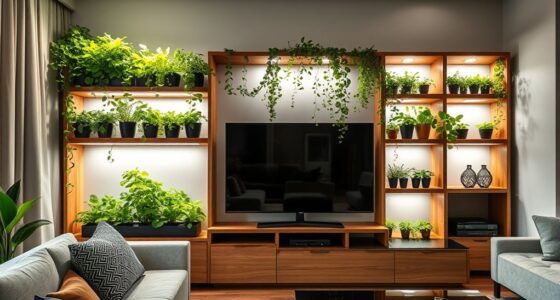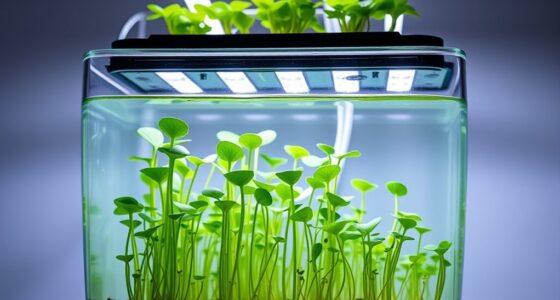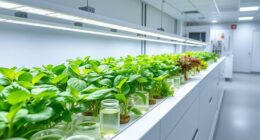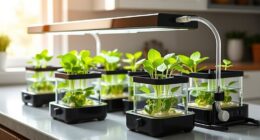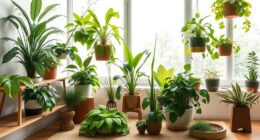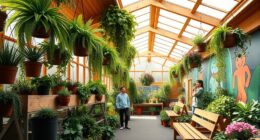If you’re short on space, hydroponic towers are your best bet because they optimize vertical growth and save ground area, letting you grow more in a small footprint. Tables, on the other hand, offer easier plant access and control but need more horizontal room. Consider your space constraints and gardening goals. Keep going to uncover detailed tips that can help you choose the perfect setup for your small-space garden.
Key Takeaways
- Hydroponic towers maximize vertical space, making them ideal for very limited horizontal areas.
- Tables provide easier plant access and flexibility but require more horizontal space.
- Towers often feature automated systems, reducing maintenance in tight spaces.
- Tables support larger or heavier crops, suitable if space allows for wider layouts.
- Choice depends on space constraints: towers excel in vertical efficiency, tables offer accessibility.
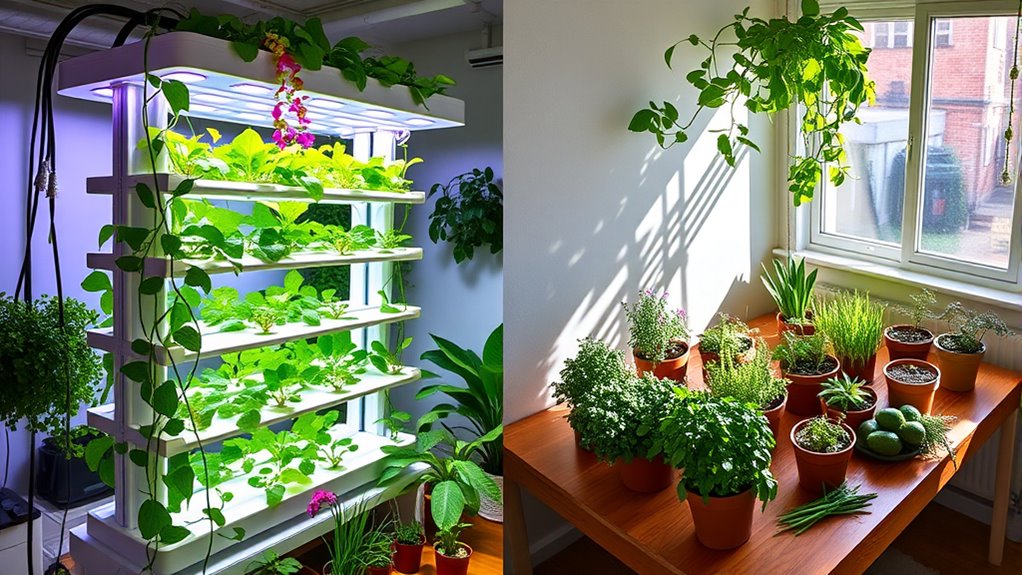
When choosing between hydroponic towers and tables, understanding their differences can help you make the best decision for your garden. Both options are popular in small spaces, but they serve different purposes depending on your goals. Hydroponic towers excel in vertical farming, allowing you to maximize limited space by growing multiple plants upward rather than outward. This vertical approach makes towers ideal for small gardens or indoor setups where horizontal space is at a premium. They typically feature stacked or tiered planters, enabling you to cultivate herbs, leafy greens, strawberries, and other small crops in a compact footprint.
If space efficiency is your main concern, hydroponic towers offer a significant advantage. By growing upward, they free up valuable ground area, leaving more room for walkways or other gardening activities. This design also helps you make the most of limited sunlight or artificial lighting, as the plants are positioned closer together vertically. Additionally, towers often incorporate automated watering and nutrient delivery systems, reducing maintenance and making vertical farming more manageable in confined spaces. Their modular nature allows you to scale your garden easily, adding or removing tiers as needed without taking up extra ground space.
On the other hand, hydroponic tables are flat, horizontal surfaces that support multiple plants spread out across a wide area. These are best suited for gardeners who prefer a more traditional approach or need easier access to individual plants for harvesting and maintenance. Tables often come in various sizes, but they usually occupy more horizontal space than towers, which can be a limitation if your space is limited. However, tables provide better airflow around the plants and can be more stable for larger or heavier crops, such as tomatoes or peppers. They also allow for easier setup of multiple planting zones and specialized growing conditions, which can be advantageous if you’re experimenting with different crops or growing techniques.
Furthermore, tables can be more suitable for gardeners who want to incorporate customized plant arrangements or specific crop layouts, as they offer more flexibility for different plant types. Ultimately, your choice depends on your available space and your gardening priorities. If you want to maximize vertical space, improve space efficiency, and create a compact, high-yield system, hydroponic towers are the way to go. But if you prefer easier access, more control over individual plants, and a traditional growing surface, hydroponic tables might suit your needs better. Both systems have their merits, but understanding how they align with your space constraints and gardening goals will help you pick the right option for your small-space garden.
Frequently Asked Questions
Which System Is Easier for Beginners to Set up and Maintain?
When choosing a system for beginners, ease of installation and maintenance matter most. You’ll find tables generally simpler because they require straightforward setup and easy access for ongoing maintenance. Towers might need more initial assembly and careful monitoring. If you want a hassle-free start, a hydroponic table offers better installation ease and maintenance simplicity, making it ideal for newcomers enthusiastic to grow without complicated setup or frequent upkeep.
How Do Costs Compare Over Time for Towers and Tables?
Imagine you’re back in the 90s, flipping through a gardening magazine, dreaming of fresh veggies. Over time, your costs differ; towers often have a higher initial investment due to their complexity, but maintenance costs can be lower since they use less water and nutrients. Tables might be cheaper upfront but could incur higher ongoing costs for replacements and upkeep. So, your long-term expenses depend on setup and how much effort you’re willing to put in.
Can Both Systems Support a Wide Variety of Crops?
Both systems can support a wide variety of crops, but your choice depends on your goals. Hydroponic towers often excel in crop diversity and system scalability, allowing you to grow leafy greens, herbs, or strawberries efficiently. Tables are versatile too, accommodating larger or more diverse plants. You’ll find that either system can be adapted to your needs, so consider the types of crops you want to grow and how scalable you need your setup to be.
What Are the Long-Term Durability Differences Between Towers and Tables?
Your choice impacts durability more than you realize—think of it as a battle of titan-like resilience! Towers made from high-quality, corrosion-resistant materials often last longer, with superior structural resilience and material longevity. Tables, especially if crafted from weaker or untreated wood, may wear out faster due to constant moisture exposure. Ultimately, investing in sturdy, weatherproof materials guarantees your system remains resilient and durable over the long term.
Do Towers or Tables Require More Space for Maintenance Access?
You’ll find that towers often require more vertical expansion to guarantee proper maintenance access, which can create accessibility challenges in tight spaces. Tables typically offer more straightforward access because of their horizontal design, making maintenance easier and quicker. So, if space is limited, tables generally have an edge, as they reduce accessibility challenges and don’t need extra vertical room for maintenance.
Conclusion
Ultimately, whether you choose hydroponic towers or tables, you’re planting seeds of growth in your small space’s future. Think of the tower as a skyscraper reaching for the sun—a symbol of vertical ambition—while the table is a sturdy foundation, grounded and reliable. Both can flourish, but your choice reflects your vision: reaching upward or staying steady. Whichever you pick, you’re nurturing a garden that blooms with possibility and hope.
